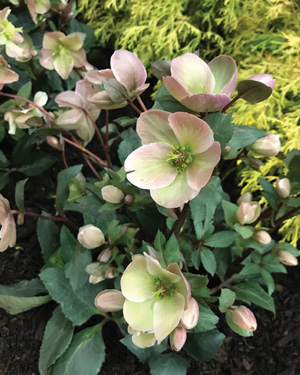
Eager to garden? Keep in mind the weather conditions. March and April could be spring-like or snowy. Pruning can be done in wintery conditions, but the soil shouldn’t be worked until the soil is 50 degrees Fahrenheit. Let’s get to work!
Winter DAMAGE
Clean up leaves and winter debris. This helps to increase soil drainage, improve water quality, and reduce algae growth later in the season.
Prune out or cut back branches damaged by the snow, wind, and ice.
Replant plants that have heaved from the freeze-thaw cycle as soon as possible to prevent further damage to the roots.
PRUNING
If you’re unsure how to prune a particular tree or shrub contact your local Cooperative Extension for guidance.
Prune summer flowering shrubs if they need restructuring or have been damaged by snow, wind, or ice.
Prune dormant Bradford pear, wisteria, butterfly bush, potentilla, honeysuckle, and flowering plums.
Don’t prune ash, oak, elm as they are “bleeders.” Don’t prune azalea, crab apple trees, forsythia, big leaf hydrangeas, lilac, mock orange, rhododendrons, weigela unless you don’t mind missing this year’s flowers which were formed last autumn.
Prune fruit trees before bud break. Prune out any branches with cankers or black knot. Be sure to clean your pruners in between cuts so you don’t spread disease!
Prune brambles (raspberries, blackberries) during March to remove dead, diseased, or damaged canes and to increase air circulation.
When pruning trees be careful not to cut flush to the trunk. Cut outside the branch collar. Wound dressing is no longer recommended.
Prune roses when forsythia bloom. (This makes use of phenology, which refers to looking at the seasons by the behavior of plants and animals not just the calendar.) Cut back dead canes to the ground. Cut back crossing canes to about one-quarter inch above an outward-facing bud.
Cut pussy willows back drastically after they bloom to encourage stronger plants and more blooms next year.
Cut back lavender into green wood late in April.
THE PLANTS, PRESENT AND FUTURE
Cut back grasses and perennials that remained as winter interest before new growth is more than a few inches to have attractive plants this year.
Add cut plant material that has not harbored disease to the compost pile.
Move mulch away from emerging spring bulbs.
Pull emerging weeds so you don’t disturb the roots of emerging perennials and bulbs. Don’t know if it is a weed or not? Let it grow. You can always remove it later. That’s what makes gardening so interesting!
Divide perennials such as liriope, hostas, daylilies, coral bells (heuchera), and Shasta daisies only when the soil is workable.
Scatter annual poppy seeds, cleome, and wildflower collection seeds for bloom later in the season.
Scrub and sterilize reusable pots and seed starter trays by washing in a dilute solution of bleach and warm water.
VEGETABLES
Plan your vegetable garden now. Be sure to rotate plant families at least every three years to prevent disease and to give time to replenish soil nutrients). Family examples include Solanaceae (tomatoes, potatoes, eggplant); Brassiaceae (cabbage, cauliflower, broccoli); and Cucurbitaceae (cucumber, melons, squash).
Direct-seed cool-season vegetables such as carrots, beets, radishes, kale, and onions.
Read seed packages so you know when to start seeds (indoors or out) and the time needed for producing plants to be set outdoors later in the season. Starting seeds indoors too early leads to tall leggy plants that won’t transplant well.
HOUSEPLANTS
Resume feeding of houseplants following directions for both dilution and applications.
Check houseplants for disease and insects. Check the roots to see if the plants need division or repotting. If you want a plant to grow larger, repot it in a container about one-inch greater in diameter but the same depth. If you want the plant to grow in the same container but its roots are taking up space, remove from the pot, root prune, and repot in fresh soil.
Prune out weak or leggy growth or toughed plant material which no longer produces leaves to stimulate new growth.
Make cuttings or divisions of appropriate plants for gifts, garden sales, or yourself.
GENERAL
If you didn’t clean and sharpen your garden tools, do it now.
Set up your rain barrel again.
Turn the compost pile.
Place new birdhouses at least twenty-five feet apart and at least five feet above the ground. Clean out and scrub older bird houses if you didn’t do it at the end of the breeding season last year.
Make cuttings to force branches of forsythia, weigelia, and pussy willows.
OTHER
Inspect stored summer tubers and rhizomes such as dahlias, caladiums, tuberous begonias, and gladiolas. Discard ones that have decayed.
If you overwintered zonal geraniums, make cuttings now.
Start seeds of slow growers now: celery, leeks, onions, pansies.
Replace fluorescent bulbs in grow lights that have been in use for more than two years.
—Carol Ann Harlos and Lyn Chimera, Master Gardeners, Erie County
Views: 12






